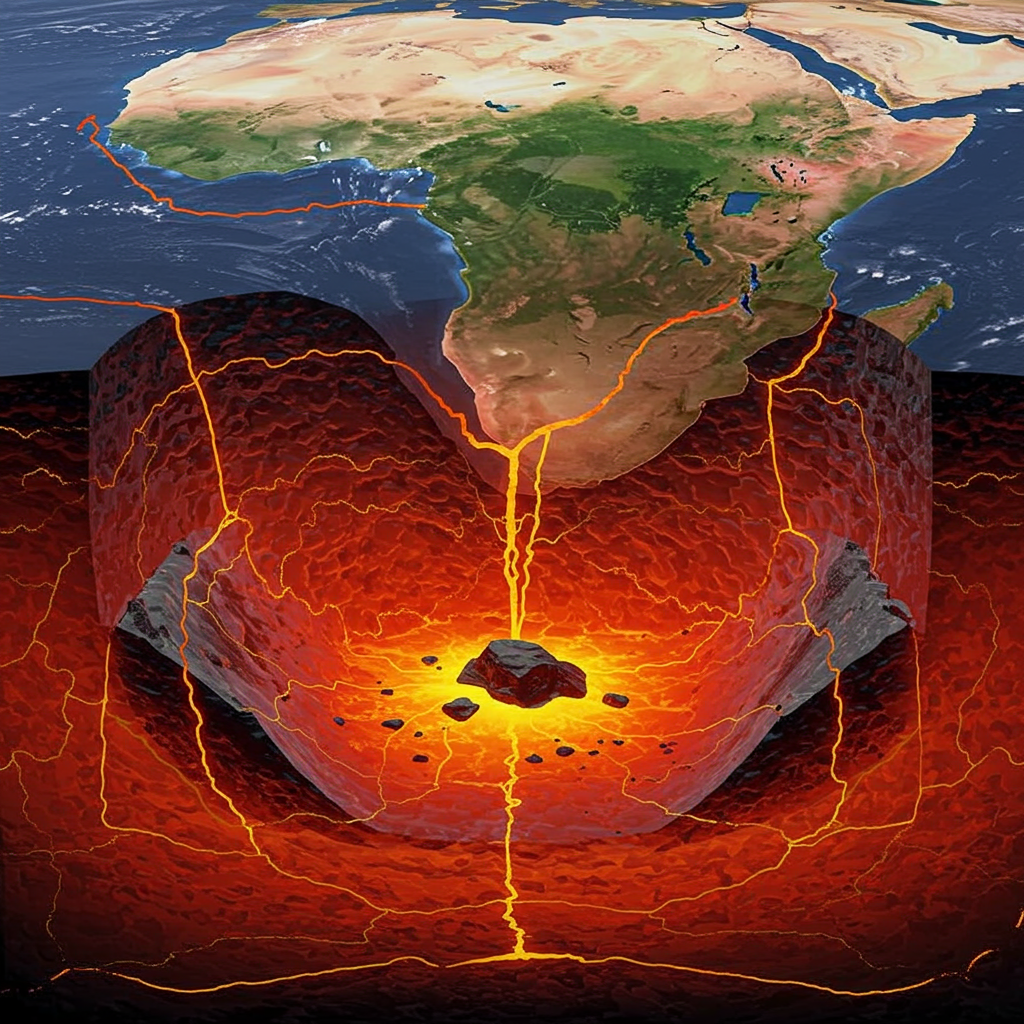Deep beneath East Africa, where colossal tectonic plates are slowly pulling apart, scientists have detected what they describe as a “heartbeat”—rhythmic pulses of molten rock rising from the Earth’s mantle. This dynamic process is centered beneath the Afar region, a unique geological hot spot where three major rifts converge. Understanding this deep-Earth activity is crucial, as it is actively contributing to the potential breakup of the African continent and the eventual birth of a new ocean basin over millions of years.
For decades, geologists have known that the Afar triple junction—where the Arabian, Nubian, and Somalian plates meet—is a classic example of continental rifting driven by the upwelling of hot material from the mantle. However, the precise nature of this upwelling, its spatial characteristics, internal composition, and how it interacts with the overriding tectonic plates has remained a subject of debate.
Unveiling the Mantle’s Secrets
To probe this deep geological mystery, a recent study significantly expanded the available data by analyzing over 130 volcanic rock samples from young volcanoes (less than 2.58 million years old, including those active in the last 11,700 years) spanning the three rift arms in Afar: the Red Sea Rift, the Gulf of Aden Rift, and the Main Ethiopian Rift. These rifts are at different stages of evolution, providing a natural laboratory to study how mantle processes co-evolve with rifting.
The researchers integrated this new, high-quality geochemical data (measuring elements and isotopes in the rocks) with existing geophysical constraints, such as seismic wave velocities (which indicate temperature and melt presence) and the depth of the boundary between the crust and mantle (Moho). By analyzing these diverse datasets together, they aimed to infer details about the composition, distribution, and relative abundance of partial melt in the mantle beneath the region.
The study found wide variability in both geochemical and geophysical signals across Afar, consistent with the presence of a substantial mantle upwelling influencing all three rifts. While crustal assimilation (magma incorporating surrounding rock) can sometimes mask deep mantle signatures, the analysis showed this effect is relatively minor in modern Afar volcanism, particularly where the crust is thinner, allowing the mantle signals to be clearly observed.
A Pulsing, Asymmetric Upwelling
Using statistical modeling to test different conceptual models of the Afar mantle upwelling, the researchers arrived at a compelling conclusion. The data is best explained by a single, complex mantle upwelling. Critically, this upwelling is not uniform or symmetrical. Instead, it is compositionally heterogeneous—meaning the rising material carries distinct chemical signatures—and its influence and distribution vary depending on which rift arm you examine.
The study revealed repeating patterns in these chemical signatures across the rift system, which some researchers have likened to a “geological barcode” or rhythmic “pulses.” This suggests the mantle material is rising intermittently, like a beating heart, from a shared source.
How Plates Shape the Mantle’s Flow
The most striking finding is that the dynamics of the overriding tectonic plates directly shape how this pulsing mantle upwelling behaves and expresses itself at the surface. The three rift arms in Afar have different characteristics:
The Red Sea Rift is a faster-spreading arm with relatively thinner crust/plate.
The Main Ethiopian Rift is slower-spreading with thicker crust/plate.
The analysis showed that the spatial length scale of the repeating chemical “pulses” or “barcodes” differs significantly between these rifts. In the faster-spreading, thinner Red Sea Rift, the pattern is stretched out, occurring over longer distances (150-200 km). In the slower-spreading, thicker Main Ethiopian Rift, the same pattern is compressed, repeating over shorter distances (50-100 km).
This difference is interpreted as the tectonic plates “channeling” the flow of the upwelling mantle material. Faster extension rates and thinner plates in the Red Sea region allow the mantle material to spread out more efficiently, like a pulse through a narrow artery. Conversely, slower extension and thicker plates in the Main Ethiopian Rift impede this flow, causing a “bottleneck” effect that compresses the spatial distribution of the compositional variations.
Implications: From Deep Earth to New Oceans
These findings provide powerful evidence that the evolution of deep mantle upwellings is intimately tied to the dynamics of the overlying tectonic plates. It’s a two-way interaction: the mantle upwelling drives rifting and volcanism, but the plates’ movement and structure also control how the mantle material flows and where its signatures appear.
This refined understanding has significant implications. It helps explain the patterns of volcanism and earthquake activity observed in rift zones like Afar. More profoundly, by studying this active process, scientists gain crucial insights into how major ocean basins, like the Atlantic, began to form millions of years ago when continents like Africa and South America first rifted apart.
In essence, the study reveals that the rhythmic “heartbeat” of the mantle beneath Africa is not just driving the continent apart but is itself being shaped by the very process it facilitates, offering a dynamic window into the powerful forces that continuously reshape our planet.




